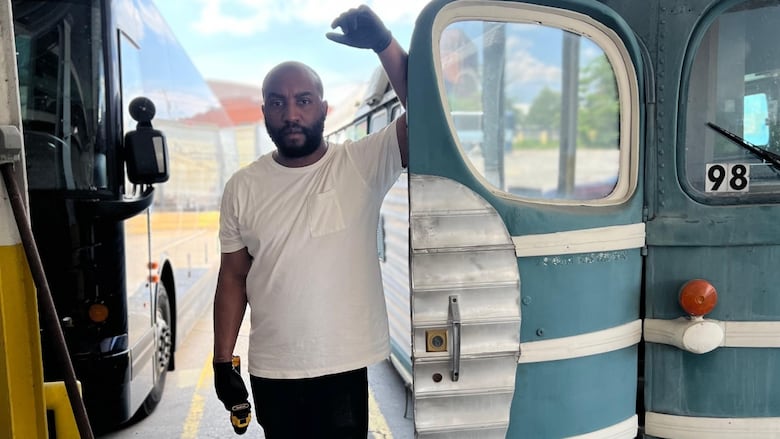This artist is transforming a Greyhound bus into a museum about Black American migration
Roughly 6 million Black Americans migrated from the South to escape Jim Crow-era racial segregation


Growing up, historian and preservationist Robert Louis Brandon Edwards would hear stories from his grandmother Ruby Mae Rollins about her life in Fredericksburg, Va., before she moved to Harlem, N.Y.
"She experienced so much segregation and discrimination, having to work in diners where she had to enter through the back … and also sitting in the balconies of movie theatres and wanting a better life for her girls," Edwards told As It Happens host Nil Köksal.
Though he didn't fully appreciate her stories at the time, Edwards says he's been able to dig deeper into his grandmother's history, thanks in part to a project he's working on for his doctoral thesis at Columbia University.
Edwards is restoring a classic, 1947 Greyhound bus, working with a Cleveland-based performing arts centre to turn the vehicle into a mobile museum highlighting the Great Migration.
Sometimes called the Great Northern Migration, the term refers to the movement of approximately six million Black Americans from the Jim Crow South for better opportunities in northern, midwestern and western states between roughly 1910 and 1970.

"[In preservation work], we tend to stick to just buildings and sites, so by me honing in on an actual mode of transportation, I want people to be transported into time back into the 1940s and '50s," said Edwards.
"I want them to not only experience that transportation, but I also want them to experience this object, this moving object as a space, and then I want them to be prompted and experience some of the experiences that an African-American traveller would have had to face."
Museum will touch on key historical moments
Once the project is completed, museum visitors will be able to don virtual reality goggles and experience what it was like for a Black traveller back when the bus still ferried passengers.
Visitors will even be prompted with different virtual experiences depending on where they choose to sit on the bus — a decision that for many Black Americans was the difference between safety and great danger.
As a result of segregated spaces on public buses and trains, Gretchen Sorin – author of Driving While Black: African American Travel and the Road to Civil Rights – says that Black Americans during the Jim Crow era didn't necessarily think of spaces like buses and trains as fully safe.

"Companies that owned the trains, owned the buses, often [segregated] African-Americans either into a 'Negro' car or they segregated them to the back of the bus," said Sorin, also director of the Cooperstown Graduate Program at SUNY Oneonta.
"While those vehicles did represent the ability to get out of the South, they were also segregated."
Instead, Sorin said that Black Americans who could afford it preferred to travel in their own vehicles.
"With your own automobile, you are in your own private space, and that space was controlled by you," she said.
Understanding the migrant experience
Most people are familiar with the history of Rosa Parks, a Black American woman who was arrested in 1955 after challenging racial segregation laws when she boarded a bus in Montgomery, Ala., and refused to give up her seat to accommodate a white passenger.
Parks's protest sparked the larger Montgomery bus boycott – culminating in a U.S. Supreme Court ruling finding that segregation on public buses was unconstitutional.
Edwards acknowledges that Rosa Parks and the Freedom Riders — civil rights activists who travelled by bus to the American South to challenge racial segregation years later — are usually the top results whenever anyone Googles the topic.
Nonetheless, he wants visitors to his museum to learn about events like the 1947 Journey of Reconciliation — sometimes called the First Freedom Ride — led by Bayard Rustin, as well as other activists who advocated for civil rights.
"I want people to think about people like Irene Morgan, who was arrested on a Greyhound bus in Virginia," said Edwards.
"But I also really want people to think about the everyday African-American traveller, like my mom, like my aunt, like my grandmother, who migrated to these different cities just in search of freedom and better opportunities and a piece of the American dream."
Edwards believes people who visit his museum will better understand what it means to be a migrant.
"Migrant has become such a nasty word that no one wants to associate themselves with but a lot of us, most of us, all of us are products of migration and it's not a bad word," he said.
"It's actually what brings us all together."

The bus is currently parked at the Greyhound Bus Station in Cleveland — an active transit hub that still receives travellers. Edwards hopes he can take his bus on the road, stopping at historic locations along the Great Migration's path.
In the meantime, he says his bus is already causing a stir among passengers who arrive in Cleveland, curious about Edwards' project — with some mistaking it for the Rosa Parks bus that's actually at the Henry Ford Museum of American Innovation in Dearborn, Mich.
"A lot of people have said, 'I've never thought of how my ancestors got to Cleveland, got to Detroit, Chicago, New York,'" said Edwards.
"The thought of that journey has never really been a thing that people focused on, it was always the point of departure and the point of arrival."
Corrections
- A previous version of this story misnamed activist Irene Morgan.Jul 17, 2025 4:27 PM EDT
Interview with Robert Louis Brandon Edwards produced by Chris Trowbridge


